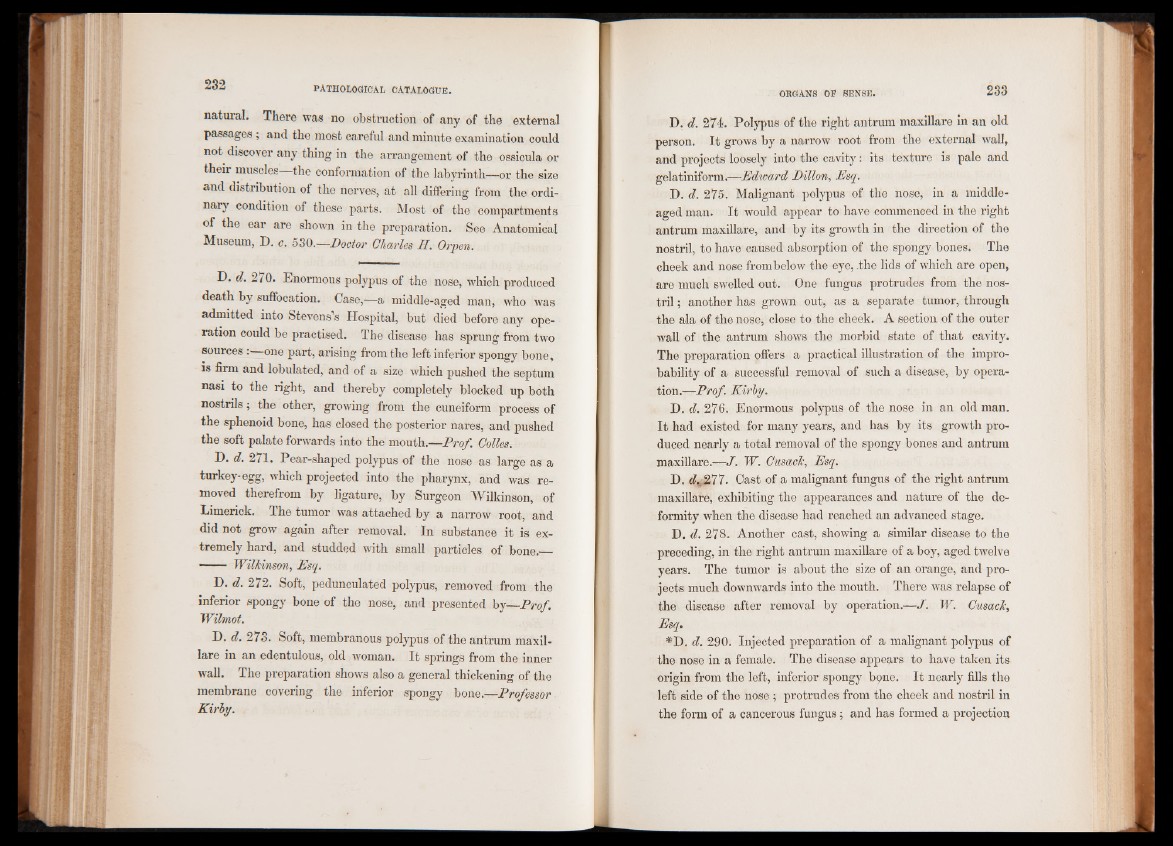
natural. There was no obstruction of any of the external
passages ; and the most careful and minute examination could
not discover any thing in the arrangement of the ossicula or
their muscles—the conformation of the labyrinth—or the size
and distribution of the nerves, at all differing from the ordinary
condition of these parts. Most of the compartments
of the ear are shown in the preparation. See Anatomical
Museum, D. c. 530.—Doctor Charles II. Orpen.
D. d. 270. Enormous polypus of the nose, which produced
death by suffocation. Case,—a middle-aged man, who was
admitted into Stevens’s Hospital, but died before any operation
could be practised. The disease has sprung from two
sources : one part, arising from the left inferior spongy bone,
is firm and lobulated, and of a size which pushed the septum
nasi to the right, and thereby completely blocked up both
nostrils; the other, growing from the cuneiform process of
the sphenoid bone, has closed the posterior nares, and pushed
the soft palate forwards into the mouth.—Prof. Colles.
D. d. 271. Pear-shaped polypus of the nose as large as a
turkey-egg, which projected into the pharynx, and was removed
therefrom by ligature, by Surgeon Wilkinson, of
Limerick. The tumor was attached by a narrow root, and
did not grow again after removal. In substance it is extremely
hard, and studded with small particles of bone.__
----- Wilkinson, Esq.
D. d. 272. Soft, pedunculated polypus, removed from the
inferior spongy bone of the nose, and presented by—Prof.
Wibnot.
D. d. 273. Soft, membranous polypus of the antrum maxil-
lare in an edentulous, old woman. It springs from the inner
wall. The preparation shows also a general thickening of the
membrane covering the inferior spongy bone.—Professor
Kirby.
D. d. 274. Polypus of the right antrum maxillare in an old
person. It grows by a narrow root from the external wall,
and projects loosely into the cavity: its texture is pale and
gelatiniform.—Edward Dillon, Esq.
D. d. 275. Malignant polypus of the nose, in a middle-
aged man. It would appear to have commenced in the right
antrum maxillare, and by its growth in the direction of the
nostril, to have caused absorption of the spongy bones. The
cheek and nose frombelow the eye, .the lids of which are open,
are much swelled out. One fungus protrudes from the nostril
; another has grown out, as a separate tumor, through
the ala of the nose, close to the cheek. A section of the outer
wall of the antrum shows the morbid state of that cavity.
The preparation offers a practical illustration of the improbability
of a successful removal of such a disease, by operation.—
Prof. Kirby.
D. d. 276. Enormous polypus of the nose in an old man.
It had existed for many years, and has by its growth produced
nearly a total removal of the spongy bones and antrum
maxillare.—J. W. Cusack, Esq.
D. dfjEll. Oast of a malignant fungus of the right antrum
maxillare, exhibiting the appearances and nature of the deformity
when the disease had reached an advanced stage.
D. d. 278. Another cast, showing a similar disease to the
preceding, in the right antrum maxillare of a boy, aged twelve
years. The tumor is about the size of an orange, and projects
much downwards into the mouth. There was relapse of
the disease after removal by operation.—J. W. Cusack,
Esq.
*D. d. 290. Injected preparation of a malignant polypus of
the nose in a female. The disease appears to have taken its
origin from the left, inferior spongy bpne. It nearly fills the
left side of the nose ; protrudes from the cheek and nostril in
the form of a cancerous fungus; and has formed a projection